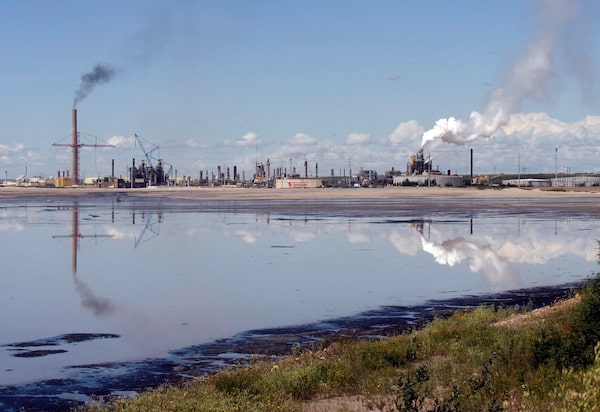
It will take a herculean effort to reduce Canada’s emissions by the targeted 40-45 per cent below 2005 levels by 2030 – let alone decarbonize the economy by 2050.Jeff McIntosh/The Canadian Press
Grant Bishop is the Founder and Chief Nerd at KnightFork, which builds data-driven tools for carbon pricing and the energy transition. He lives in Calgary.
Last month, Canada saw two important consultations for Ottawa’s plan to reach net-zero greenhouse gas emissions by 2050 – highlighting the country’s shortcomings on making publicly available the data that are necessary to achieve the target.
The Canadian Securities Administrators (CSA) has proposed mandatory disclosure of carbon emissions by public companies (the agency has extended the comment period until Feb. 16). Separately, Environment and Climate Change Canada (ECCC) held consultations to review the industry benchmarks that apply to large industrial emitters under the federal output-based pricing system.
Key datasets are spread across federal agencies and the provinces, and fragmented among public and private sources. Critical datasets are not publicly available, while others are only accessible at a prohibitive cost. Without more timely and granular data about emissions by specific companies and their facilities, investors and lenders can’t accurately evaluate an individual company’s true financial exposure to carbon pricing. Stakeholders in the policy process can’t meaningfully assess the impacts of different regulations.
The consequences are significant: It will take a herculean effort to reduce Canada’s emissions by the targeted 40-45 per cent below 2005 levels by 2030 – let alone decarbonize the economy by 2050. But we can only solve the macro-scale puzzle with the many small pieces – that is, project-by-project engineering designs and on-the-ground investment decisions to abate emissions.
Bank of Canada plans new tools to better assess how climate change is impacting the economy
The decisions by investors – whether institutional or retail – and the terms for credit available to companies will determine what emissions-reduction investments are made, or if they are made at all. This is why it’s essential to have readily available data about who emits what and where.
On this front, the CSA has proposed that public companies be required to disclose their Scope 1 emissions, defined as those “tailpipe” and “stack” emissions directly produced by the operation of their businesses.
This is commendable, but it is not enough. Most companies in carbon-intensive sectors already disclose their overall Scope 1 emissions. Many also disclose their total Scope 2 emissions (indirect emissions from electricity consumption) and Scope 3 (emissions from a company’s production inputs, as well as from the use of its products).
But what investors really need in order to analyze companies’ carbon exposure is more detailed information about where the emissions occur and what compliance costs companies face.
For carbon emissions, by far the most comprehensive and easily comparable template is the CDP (formerly the “Carbon Disclosure Project”) questionnaire. The questionnaire includes detailed responses on a company’s emissions targets, investments in abatement projects and technology, emissions subject to different carbon pricing regimes, and the breakdown of Scope 1 and 2 emissions by geography, business unit and facility. Many Canadian companies, such as TransAlta and Suncor, publish their CDP submissions on their own webpages.
Data with the kind of detail and granularity required by the CDP is what the CSA should require companies to disclose. Since carbon costs will become an increasingly significant factor in many companies’ performance, investors should have the necessary information to evaluate that risk.
Meanwhile, ECCC is reviewing the stringency of its benchmarks for product-by-product emission intensity (carbon emission per unit of production) under the federal output-based pricing system (OBPS), to ensure Canadian industry reduces its emissions.
The federal OBPS applies in provinces and territories that the federal government considers to lack strong enough carbon-pricing regimes of their own, or who request the system. It applies in Manitoba, Prince Edward Island, Yukon, Nunavut and partly in Saskatchewan, and applied in Ontario until Jan. 1, 2022, when the province’s own standards came into effect.
Under the OBPS, an emitter does not pay the full headline carbon price, which is $50 a tonne in 2022. Instead, they are given free credits based on production of a given product, such as barrels of oil, megawatt hours of power generation, tonnes of rolled steel or cement. The result is that a facility pays an effective carbon cost only on the difference between the facility’s emission intensity and the benchmark for a given product. For example, if a facility’s emission intensity exceeds its benchmark by around 10 per cent, it would pay only $5 a tonne, even though the headline carbon price is $50 per tonne.
The OBPS benchmarks were purportedly based on the national, production-weighted average emissions intensity for each product. However, ECCC has never publicly disclosed the underlying data on which these benchmarks were based.
In two papers for the C.D. Howe Institute, I used facility-level production data to show that federal carbon pricing regulations for electricity generators were biased in favour of coal and that Alberta’s carbon pricing regulations for the oil sands actually made lower-emissions facilities less economically competitive. These analyses were only possible because of the detailed data published by Alberta regulators. Yet, ECCC has not made this same data publicly available on a national scale.
Unless governments in Canada make more data available, they are letting us fly blind on the implications of decarbonization and the energy transition. More information helps markets work better, and market participants should be able to see the full chessboard. In order to get to net zero, Canada must move beyond the big picture and let us understand what is happening on the ground.
Keep your Opinions sharp and informed. Get the Opinion newsletter. Sign up today.